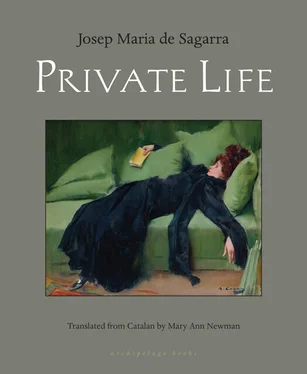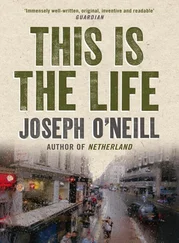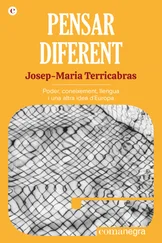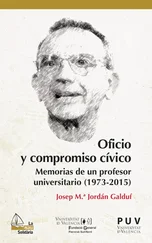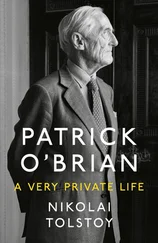Josep Maria de Sagarra - Private Life
Здесь есть возможность читать онлайн «Josep Maria de Sagarra - Private Life» весь текст электронной книги совершенно бесплатно (целиком полную версию без сокращений). В некоторых случаях можно слушать аудио, скачать через торрент в формате fb2 и присутствует краткое содержание. Год выпуска: 2015, ISBN: 2015, Издательство: Archipelago, Жанр: Современная проза, на английском языке. Описание произведения, (предисловие) а так же отзывы посетителей доступны на портале библиотеки ЛибКат.
- Название:Private Life
- Автор:
- Издательство:Archipelago
- Жанр:
- Год:2015
- ISBN:978-0-914671-27-5
- Рейтинг книги:3 / 5. Голосов: 1
-
Избранное:Добавить в избранное
- Отзывы:
-
Ваша оценка:
- 60
- 1
- 2
- 3
- 4
- 5
Private Life: краткое содержание, описание и аннотация
Предлагаем к чтению аннотацию, описание, краткое содержание или предисловие (зависит от того, что написал сам автор книги «Private Life»). Если вы не нашли необходимую информацию о книге — напишите в комментариях, мы постараемся отыскать её.
for its contemporaries, was a scandal in 1932. The 1960's edition was bowdlerized by Franco's censors. Part Lampedusa, part Genet, this translation will bring an essential piece of 20th-century European literature to the English-speaking public.
Private Life — читать онлайн бесплатно полную книгу (весь текст) целиком
Ниже представлен текст книги, разбитый по страницам. Система сохранения места последней прочитанной страницы, позволяет с удобством читать онлайн бесплатно книгу «Private Life», без необходимости каждый раз заново искать на чём Вы остановились. Поставьте закладку, и сможете в любой момент перейти на страницу, на которой закончили чтение.
Интервал:
Закладка:
Barcelona shimmered like an international shooting star. In the publicity published abroad about the Exposition, the financial “fiddling” of the magnates of the situation swelled to cosmic proportions. Anyone who didn’t brazenly steal simply didn’t have fingers, poor thing.
When it was over, people cringed, wondering how such things could have been tolerated. But the fact that they put up with it, and accepted it, was very natural. Politicians know that there is nothing so mutable, so easy to fool, so corruptible, as a mob. And in those days Barcelona, Catalonia and Spain were just that: a great mob of small intestines and rubberneckers. The Dictatorship filled shriveled stomachs with crusts of bread and offered up a bit of fireworks to cast a reflex of red happiness on their curious faces. Cowardice and stupidity on all sides contributed to the game, and yet it cannot be denied that Barcelona did have a brilliant, stupendously decorative moment.
The stale old aristocracy and the fresh new aristocracy that have popped up in this book felt as if they really were somebody. The pneumatic tires that the Hispanos-Suizas and Rolls-Royces set into motion had the grandeur of a Roman catapult. The upholstery might be a little the worse for wear, but it exuded a deeply human breath, like the breasts of slave times. The buttocks of the aristocrats that flattened it out on their return from kissing the hand of the queen would soak up the genuflections of all the workers of Murcia, ripping out rails and bursting pipes without the slightest fear of a rebel bullet.
But this happiness was not to last. Stocks began to wobble; currency began to wobble; the dictator was tired and everyone was tired of the dictator. The king gave him a kick in the belly, with the cold, geological cruelty that is the province of kings. As Primo de Rivera had the good fortune to die a dull and decent death in Paris, no one asked for his head. In a word, it was a blunt, primary, and not at all perverse sort of biology. A biology of the kind cultivated in a Spanish barracks, over a bottle of wine, a deck of cards, and a nameless chanteuse, a homegrown version of la Bella Chelito , doing a belly dance in a dressing gown festooned with ribbons and bows. The dictator sought to extend the nineteenth century military chaos that had been stemmed by the alternating two-party system imposed by Cánovas del Castillo. When Primo de Rivera left, not a single bone of either the military anarchy or the Cánovas system was left unbroken. The monarchy dragged its tail for a good long time, and no line it was thrown could help. In Jaca two captains with communist pipe dreams faced the firing squad, but things got even worse. A few months later, not a single city or town was left in Spain without a street or town square bearing the names of those two martyred captains. One fine day people woke up to find the Republic in the streets. People seized onto the Republic in childlike amazement, without bloodshed or vengeance. The Conde de Romanones went to the Escorial to send the queen off. The count sat on a wooden bench at the train station, with his moustache, his twisted hat, and his desolately historic eyes. Not far from his shoe stood an empty bottle of Sinalco, the oldest soft drink in Europe. In those days, in El Escorial, they still drank Sinalco.
The queen left Spain like a lady-in-waiting wearing a necklace of tears. No one dared steal even a petal of the disintegrating roses she held in a large, pallid, and misty bouquet, watered with the sobs of the aristocracy.
The king had fled hours before. In Barcelona the Catalan Republic was proclaimed, and the Plaça de Sant Jaume celebrated one of the most enthusiastic, sweaty and sublime days of its history.
In the five years that transpired between the 1929 Exposition and advent of the Republic, the daily uncertainties in the private life of the people we have met in the pages of this book continued to be resolved behind the blindfold destiny reserves for us all. Those were thorny days for the Lloberolas. The most brilliant moment of the Exposition coincided with the most bitter moment for don Tomàs: a failed inheritance.
Don Tomàs had a paternal aunt, his father’s younger sister, known to at least four hundred Barcelonans as la Tia Paulina. Tia Paulina had been widowed at a very young age. With no surviving family on the side of the deceased, she inherited her husband’s entire fortune free of taxes or obligations. Tia Paulina had sole possession of the cut she took away from the house of the Lloberolas because, even though Don Tomàs’s father was the absolute heir, the part bequeathed to her as inalienable successor represented a considerable inheritance, which in time quintupled in value.
The only possible heirs to Tia Paulina were Don Tomàs, his sisters, and the Baró de Gresol, a second cousin to Don Tomàs. Despite being a more distant relation, the Baró de Gresol was Tia Paulina’s godson. That good lady had always shown him great affection.
Tia Paulina had been born in 1840, at the ancestral home of the Lloberolas. Her birth was met with the scent of the last blasts of powder from the first civil war. She made her communion in a tiny hoop skirt that reached below her knees, beneath which you could see white silk pantaloons that covered her little partridge feet in hoops of lace trim. Tia Paulina had been a silent, anemic child, terrified of devils, freemasons, and the wayward ways of Queen Isabella II. She spent winters shut up in a school run by the Sisters of the Holy Family who had her sing songs under the trees of a damp garden and taught her to embroider on a canemàs — or canyamàs , as the ladies who did embroidery Catalanized the Spanish cañamazo . On this embroidery canvas Tia Paulina would stitch images of the baby Jesus, of General Zumalacárregui, and of the Lloberola family coat of arms in wool of many colors.
Tia Paulina spent the summers in a little town close to Perpignan where the Lloberolas had an estate. Most of the trip was made in enormous ramshackle stagecoaches. Tia Paulina would suffocate in the heat and turn fuchsia red. Once, the stagecoach was shot at and robbed by bandits as it made its way through the province of Girona. One of the thugs stuck his big hairy hand into the warmth of Tia Paulina’s corset to see if she was hiding any jewels there. Her two small breasts were tiny and green as an almond hull. She fainted. For four years after that she would tell the priests when she went to confession how a big thuggish man had touched her that way. At the Perpignan estate, Tia Paulina listened to the song of the crickets and the warblers. Her hair was combed every day, she was bathed twice a year, and her little body was enshrouded in a long gown made of something like sackcloth that reached down to her feet. Tia Paulina was very white and very sad. She read Chateaubriand’s Les martyrs and a romantic little French novel called La siège de la Rochelle . That novel was the basis for her criteria on love.
At eighteen years of age she was married off to el Senyor de Llinàs. Out of family expediency, he sympathized with the Carlist cause, but in fact el Senyor de Llinàs was a somewhat brutal Voltairean; he moved with great ease from gunpowder to laughter. The wedding night was a monstrous affair for Tia Paulina; her mother’s instructions proved utterly worthless.
After two years of marriage she began to feel a deep adoration for her husband. Even though the realization that el Senyor de Llinàs was not the slightest bit religious caused her great suffering, that apoplectic man’s moustache — an exact copy of Napoleon III’s — had pervaded her heart.
El Senyor de Llinàs impregnated every chambermaid and cook in their home, but he never managed to impregnate the womb of Tia Paulina.
Читать дальшеИнтервал:
Закладка:
Похожие книги на «Private Life»
Представляем Вашему вниманию похожие книги на «Private Life» списком для выбора. Мы отобрали схожую по названию и смыслу литературу в надежде предоставить читателям больше вариантов отыскать новые, интересные, ещё непрочитанные произведения.
Обсуждение, отзывы о книге «Private Life» и просто собственные мнения читателей. Оставьте ваши комментарии, напишите, что Вы думаете о произведении, его смысле или главных героях. Укажите что конкретно понравилось, а что нет, и почему Вы так считаете.
